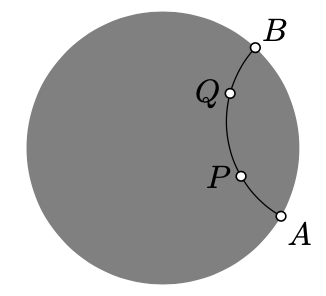12.4: Axiom I
- Page ID
- 23657
\( \newcommand{\vecs}[1]{\overset { \scriptstyle \rightharpoonup} {\mathbf{#1}} } \)
\( \newcommand{\vecd}[1]{\overset{-\!-\!\rightharpoonup}{\vphantom{a}\smash {#1}}} \)
\( \newcommand{\dsum}{\displaystyle\sum\limits} \)
\( \newcommand{\dint}{\displaystyle\int\limits} \)
\( \newcommand{\dlim}{\displaystyle\lim\limits} \)
\( \newcommand{\id}{\mathrm{id}}\) \( \newcommand{\Span}{\mathrm{span}}\)
( \newcommand{\kernel}{\mathrm{null}\,}\) \( \newcommand{\range}{\mathrm{range}\,}\)
\( \newcommand{\RealPart}{\mathrm{Re}}\) \( \newcommand{\ImaginaryPart}{\mathrm{Im}}\)
\( \newcommand{\Argument}{\mathrm{Arg}}\) \( \newcommand{\norm}[1]{\| #1 \|}\)
\( \newcommand{\inner}[2]{\langle #1, #2 \rangle}\)
\( \newcommand{\Span}{\mathrm{span}}\)
\( \newcommand{\id}{\mathrm{id}}\)
\( \newcommand{\Span}{\mathrm{span}}\)
\( \newcommand{\kernel}{\mathrm{null}\,}\)
\( \newcommand{\range}{\mathrm{range}\,}\)
\( \newcommand{\RealPart}{\mathrm{Re}}\)
\( \newcommand{\ImaginaryPart}{\mathrm{Im}}\)
\( \newcommand{\Argument}{\mathrm{Arg}}\)
\( \newcommand{\norm}[1]{\| #1 \|}\)
\( \newcommand{\inner}[2]{\langle #1, #2 \rangle}\)
\( \newcommand{\Span}{\mathrm{span}}\) \( \newcommand{\AA}{\unicode[.8,0]{x212B}}\)
\( \newcommand{\vectorA}[1]{\vec{#1}} % arrow\)
\( \newcommand{\vectorAt}[1]{\vec{\text{#1}}} % arrow\)
\( \newcommand{\vectorB}[1]{\overset { \scriptstyle \rightharpoonup} {\mathbf{#1}} } \)
\( \newcommand{\vectorC}[1]{\textbf{#1}} \)
\( \newcommand{\vectorD}[1]{\overrightarrow{#1}} \)
\( \newcommand{\vectorDt}[1]{\overrightarrow{\text{#1}}} \)
\( \newcommand{\vectE}[1]{\overset{-\!-\!\rightharpoonup}{\vphantom{a}\smash{\mathbf {#1}}}} \)
\( \newcommand{\vecs}[1]{\overset { \scriptstyle \rightharpoonup} {\mathbf{#1}} } \)
\( \newcommand{\vecd}[1]{\overset{-\!-\!\rightharpoonup}{\vphantom{a}\smash {#1}}} \)
\(\newcommand{\avec}{\mathbf a}\) \(\newcommand{\bvec}{\mathbf b}\) \(\newcommand{\cvec}{\mathbf c}\) \(\newcommand{\dvec}{\mathbf d}\) \(\newcommand{\dtil}{\widetilde{\mathbf d}}\) \(\newcommand{\evec}{\mathbf e}\) \(\newcommand{\fvec}{\mathbf f}\) \(\newcommand{\nvec}{\mathbf n}\) \(\newcommand{\pvec}{\mathbf p}\) \(\newcommand{\qvec}{\mathbf q}\) \(\newcommand{\svec}{\mathbf s}\) \(\newcommand{\tvec}{\mathbf t}\) \(\newcommand{\uvec}{\mathbf u}\) \(\newcommand{\vvec}{\mathbf v}\) \(\newcommand{\wvec}{\mathbf w}\) \(\newcommand{\xvec}{\mathbf x}\) \(\newcommand{\yvec}{\mathbf y}\) \(\newcommand{\zvec}{\mathbf z}\) \(\newcommand{\rvec}{\mathbf r}\) \(\newcommand{\mvec}{\mathbf m}\) \(\newcommand{\zerovec}{\mathbf 0}\) \(\newcommand{\onevec}{\mathbf 1}\) \(\newcommand{\real}{\mathbb R}\) \(\newcommand{\twovec}[2]{\left[\begin{array}{r}#1 \\ #2 \end{array}\right]}\) \(\newcommand{\ctwovec}[2]{\left[\begin{array}{c}#1 \\ #2 \end{array}\right]}\) \(\newcommand{\threevec}[3]{\left[\begin{array}{r}#1 \\ #2 \\ #3 \end{array}\right]}\) \(\newcommand{\cthreevec}[3]{\left[\begin{array}{c}#1 \\ #2 \\ #3 \end{array}\right]}\) \(\newcommand{\fourvec}[4]{\left[\begin{array}{r}#1 \\ #2 \\ #3 \\ #4 \end{array}\right]}\) \(\newcommand{\cfourvec}[4]{\left[\begin{array}{c}#1 \\ #2 \\ #3 \\ #4 \end{array}\right]}\) \(\newcommand{\fivevec}[5]{\left[\begin{array}{r}#1 \\ #2 \\ #3 \\ #4 \\ #5 \\ \end{array}\right]}\) \(\newcommand{\cfivevec}[5]{\left[\begin{array}{c}#1 \\ #2 \\ #3 \\ #4 \\ #5 \\ \end{array}\right]}\) \(\newcommand{\mattwo}[4]{\left[\begin{array}{rr}#1 \amp #2 \\ #3 \amp #4 \\ \end{array}\right]}\) \(\newcommand{\laspan}[1]{\text{Span}\{#1\}}\) \(\newcommand{\bcal}{\cal B}\) \(\newcommand{\ccal}{\cal C}\) \(\newcommand{\scal}{\cal S}\) \(\newcommand{\wcal}{\cal W}\) \(\newcommand{\ecal}{\cal E}\) \(\newcommand{\coords}[2]{\left\{#1\right\}_{#2}}\) \(\newcommand{\gray}[1]{\color{gray}{#1}}\) \(\newcommand{\lgray}[1]{\color{lightgray}{#1}}\) \(\newcommand{\rank}{\operatorname{rank}}\) \(\newcommand{\row}{\text{Row}}\) \(\newcommand{\col}{\text{Col}}\) \(\renewcommand{\row}{\text{Row}}\) \(\newcommand{\nul}{\text{Nul}}\) \(\newcommand{\var}{\text{Var}}\) \(\newcommand{\corr}{\text{corr}}\) \(\newcommand{\len}[1]{\left|#1\right|}\) \(\newcommand{\bbar}{\overline{\bvec}}\) \(\newcommand{\bhat}{\widehat{\bvec}}\) \(\newcommand{\bperp}{\bvec^\perp}\) \(\newcommand{\xhat}{\widehat{\xvec}}\) \(\newcommand{\vhat}{\widehat{\vvec}}\) \(\newcommand{\uhat}{\widehat{\uvec}}\) \(\newcommand{\what}{\widehat{\wvec}}\) \(\newcommand{\Sighat}{\widehat{\Sigma}}\) \(\newcommand{\lt}{<}\) \(\newcommand{\gt}{>}\) \(\newcommand{\amp}{&}\) \(\definecolor{fillinmathshade}{gray}{0.9}\)Evidently, the h-plane contains at least two points. Therefore, to show that Axiom I holds in the h-plane, we need to show that the h-distance defined in 12.1 is a metric on h-plane; that is, the conditions (a) - (d) in Definition 1.3.1 hold for h-distance.
The following claim says that the h-distance meets the conditions (a) and (b)
Given the h-points \(P\) and \(Q\), we have \(PQ_h \ge 0\) and \(PQ_h=0\) if and only if \(P=Q\).
- Proof
-
According to Lemma 12.3.1 and the main observation (Theorem 12.3.1), we may assume that \(Q\) is the center of the absolute. In this case
and therefore
Moreover, the equalities holds if and only if \(P=Q\).
The following claim says that the h-distance meets the condition
For any h-points \(P\) and \(Q\), we have \(PQ_h=QP_h\).
- Proof
-
Let \(A\) and \(B\) be ideal points of \((PQ)_h\) and \(A,P,Q,B\) appear on the circline containing \((PQ)_h\) in the same order.

Then
\(\begin{array} {rcl} {PQ_h} & = & {\ln \dfrac{AQ \cdot BP}{QB \cdot PA} =} \\ {} & = & {=\ln \dfrac{BP \cdot AQ}{PA \cdot QB}=} \\ {} & = & {QP_h} \end{array}\)
The following claim shows, in particular, that the triangle inequality (which is Definition 1.3.1d) holds for \(h\)-distance.
Given a triple of h-points \(P\), \(Q\), and \(R\), we have
Moreover, the equality holds if and only if \(P\), \(Q\), and \(R\) lie on one h-line in the same order.
- Proof
-
Without loss of generality, we may assume that \(P\) is the center of the absolute and \(PQ_h \ge QR_h >0\).
Suppose that \(\Delta\) denotes the h-circle with the center \(Q\) and h-radius \(\rho=QR_h\). Let \(S\) and \(T\) be the points of intersection of \((PQ)\) and \(\Delta\).
By Lemma 12.3.3, \(PQ_h\z\ge QR_h\). Therefore, we can assume that the points \(P\), \(S\), \(Q\), and \(T\) appear on the h-line in the same order.
According to Lemma Lemma 12.3.4, \(\Delta\) is a Euclidean circle; suppose that \(\hat Q\) denotes its Euclidean center. Note that \(\hat Q\) is the Euclidean midpoint of \([ST]\).

By the Euclidean triangle inequality
\[PT = P\hat{Q}+\hat{Q} R \ge PR\]
and the equality holds if and only if \(T=R\).
By Lemma Lemma 12.3.2,
\(\begin{array} {l} {PT_h = \ln \dfrac{1 + PT}{1 - PT},} \\ {PR_h = \ln \dfrac{1 + PR}{1 - PR}.} \end{array}\)
Since the function \(f(x)=\ln\frac{1+x}{1-x}\) is increasing for \(x\in[0,1)\), inequality 12.4.1 implies
\(PT_h\ge PR_h\)
and the equality holds if and only if \(T=R\).
Finally, applying Lemma 12.3.3 again, we get that
\(PT_h=PQ_h+QR_h.\)
Hence the claim follows.


